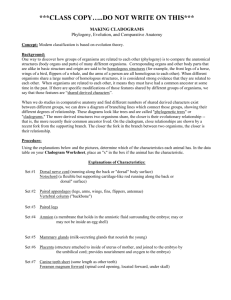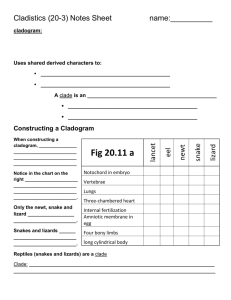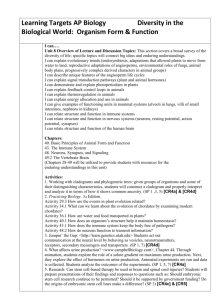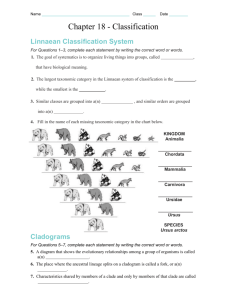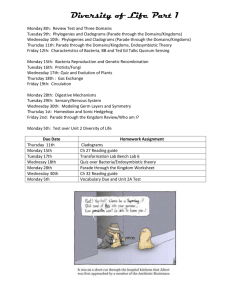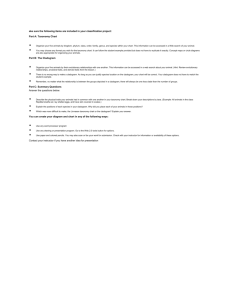Script
advertisement
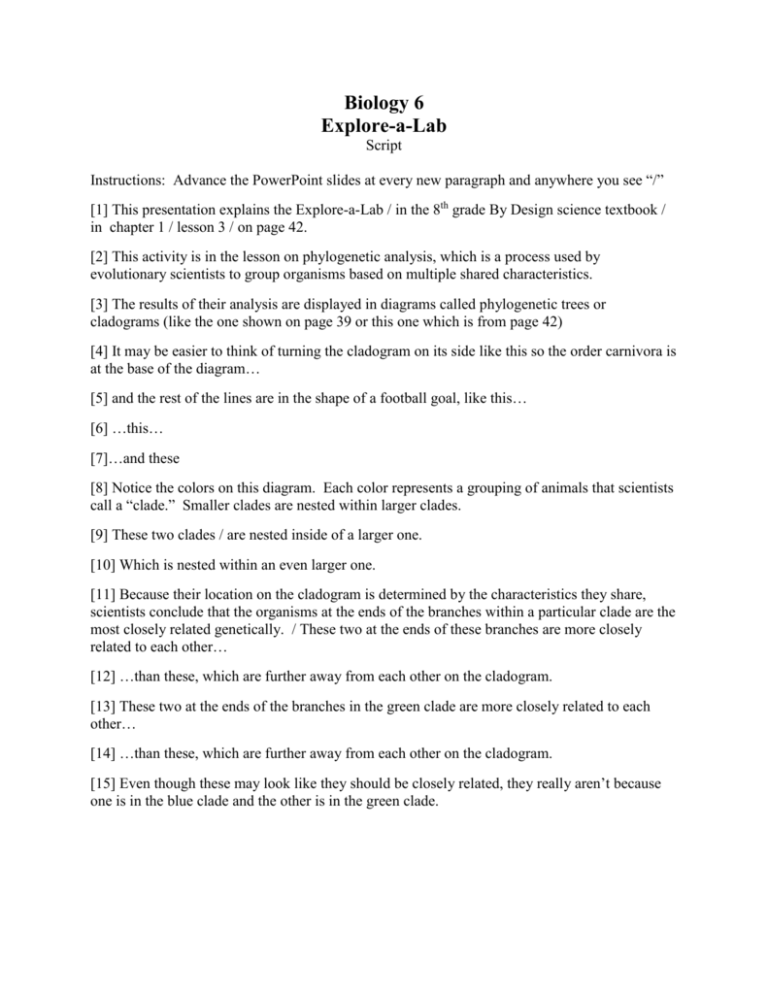
Biology 6 Explore-a-Lab Script Instructions: Advance the PowerPoint slides at every new paragraph and anywhere you see “/” [1] This presentation explains the Explore-a-Lab / in the 8th grade By Design science textbook / in chapter 1 / lesson 3 / on page 42. [2] This activity is in the lesson on phylogenetic analysis, which is a process used by evolutionary scientists to group organisms based on multiple shared characteristics. [3] The results of their analysis are displayed in diagrams called phylogenetic trees or cladograms (like the one shown on page 39 or this one which is from page 42) [4] It may be easier to think of turning the cladogram on its side like this so the order carnivora is at the base of the diagram… [5] and the rest of the lines are in the shape of a football goal, like this… [6] …this… [7]…and these [8] Notice the colors on this diagram. Each color represents a grouping of animals that scientists call a “clade.” Smaller clades are nested within larger clades. [9] These two clades / are nested inside of a larger one. [10] Which is nested within an even larger one. [11] Because their location on the cladogram is determined by the characteristics they share, scientists conclude that the organisms at the ends of the branches within a particular clade are the most closely related genetically. / These two at the ends of these branches are more closely related to each other… [12] …than these, which are further away from each other on the cladogram. [13] These two at the ends of the branches in the green clade are more closely related to each other… [14] …than these, which are further away from each other on the cladogram. [15] Even though these may look like they should be closely related, they really aren’t because one is in the blue clade and the other is in the green clade. [16] The Explore-a-Lab asks the question: How many ways can the same organisms be grouped into different cladograms? Students will discover that items can be grouped in many different ways depending on which characteristics they select, which has important implications as students learn about the theory of evolution. The point of this Explore-a-Lab is to compare the results of several different sorting activities. If your class is too small to have several groups, each group could sort the same utensils multiple times using different characteristics to generate several different sets of results. [17] Provide each group of students with a variety of kitchen utensils like these. It is important that each group have the same utensils. [18] Instruct your students to discuss the characteristics of the kitchen utensils and then sort them into groups based on any characteristic they choose. [19] This is one of many possibilities students may come up with. [20] Once students have sorted the utensils into two categories, instruct each group to begin drawing a cladogram on a large sheet of paper. [21] Tell them to begin their cladograms near the bottom of their paper and leave room at the top to expand it further. Instead of the pictures shown here, your students could list the utensils in each group. [22] Instruct your students to sort each group into at least two more groups and add the new groups to their cladograms. [23] The spoons could be divided into two groups this way: spoons for individual use and serving spoons. [24] Which could be placed on the cladogram like this. [25] If the non-spoon group was sorted into two more groups based on whether they contain any metal or not… [26] They could be placed on the cladogram like this. [27] You may want to encourage your students to divide the utensils into even smaller groups [28] In order to generate more results that we can compare, consider different characteristics we could have used to sort the same utensils. [29] Let’s say that a group decided to sort first by whether or not the utensils contains any metal. [30] The first step of their cladogram would look like this. [31] Sorting the non-metal utensils again… [32] Could result in these two groups… [33] …which could look like this on the cladogram. [34] You may want to encourage students to sort the utensils into more than just two groups at any step along the way [35] There are lots of possibilities for sorting the group of metal utensils. [36] Here are 5 possible groupings of the metal utensils. Expect your students to disagree on exactly how to group the utensils. This is a good thing, which will help to make the point of this activity. [37] For example, someone might argue that the spaghetti tongs should go in the pointy group. [38] Someone else might want to classify them with other serving items. [39] It could be argued that the grapefruit spoon could be in the pointy group or the spoon group [40] Some might suggest that the miscellaneous group should be split up. [41] Here is a third example of sorting options so that we’ll have several groupings to compare. [42] Let’s say this time we categorize first by the material each utensil is made of. [43] Those made of only one material are made either of stainless steel, plastic, or silver. [44] The utensils made of more than one material could be divided into wood and rubber, wood and metal, metal and soft plastic, and metal and hard plastic. [45] When your students make their cladograms, they would show all these categories… [46] …and all these categories on the same cladograms. [47] Here’s the point of this exercise. Remember how the proximity of two organisms on a cladogram is supposed to show how similar they are to each other? [48] Keep that in mind as we compare where the cookie scoop ended up in the three sorting exercises we just did. [49] In the first sorting activity, we first sorted into two groups—spoons and non-spoons. Then we sorted into two more groups—metal and non-metal. The cookie scoop ended up in a group with a couple of cake servers and a pair of tongs. [50] In the second sorting activity, the cookie scoop ended up between an ice-cream scoop and a gravy ladle. [51] And in the third sorting activity it ended up in a group with a little gadget that clips to the edge of a pot so you can rest a wooden spoon in it. How can a cookie scoop be most like a pair of tongs one time, an ice cream scoop another time, and a gadget like this another time? It all depends on the characteristics you use in the sorting process. [52] The same thing happens when scientists sort organisms using phylogenetic trees, although cladograms of species normally show fewer variations than a cladogram of kitchen utensils. Where the organisms end up—and which other organisms they are closest to—is determined by which characteristics are used in the sorting process. [53] That is why some cladograms suggest that our closest relatives are chimpanzees… [54] …while others suggest we are most like gorillas, orangutans, or bonobos. [55] Instruct your students to observe each other’s cladograms. Compare the proximity of certain utensils to each other on different cladograms. Perhaps each student should select one utensil and compare what it is grouped with in each of the other groups. Help them discover that the characteristics used in the sorting process, determine which utensils end up close together. [56] The characteristics we sort by are observable data. [57] But the suggested relationships between objects or organisms are interpretations of that data. Any cladogram is only one of many possible arrangements. Sorting by different characteristics will produce a different arrangement of organisms. [58] Cladograms assume evolution happened, and then try to figure out who is most closely related to whom. / Although phylogenetic analysis may be a useful tool for sorting organisms by shared characteristics, / cladograms do not provide actual evidence that evolution really happened.


